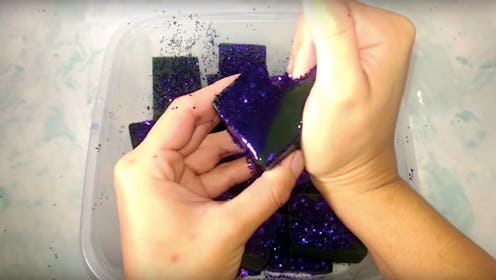Life
These Viral Videos Of People Tearing Apart Foam That Flowers Go In Are Actually So Soothing
A table of deep green, foam blocks sits in a plastic tub of water on a table. Hands enter from either side of the screen, select a block, and lift it into closer focus. As the left hand holds it steady, the rights begins to dismantle the block, pulling the foam apart piece by piece — allowing the water that once saturated it to fall into its original container. Every minute, sonic detail is amplified for the video's entire two minutes and thirty eight seconds. This is only one example of the floral foam ASMR videos taking the web by storm.
ASMR stands for autonomous sensory meridian response, the technical term used to describe static-like tingles a person may experience around the head, neck, spine, and elsewhere when exposed to certain audio and visual triggers. It was originally coined in 2010 by a woman named Jennifer Allen in a Facebook group, according to the Washington Post, but has since gained a loyal following of people who view the phenomenon as an effective therapeutic technique. Even if you are unfamiliar with the concept, you have likely encountered the videos that have all but taken over Instagram and YouTube. Typically the videos depict a person whispering, tapping a surface, or ripping and crumpling paper. The more popular figures behind these brief, cathartic clips have attracted sizable followings (user Gentle Whispering ASMR, for example, has over 1.2 million people following her Youtube channel).
But, the newest subgenre of ASMR shies away from speaking, and relies on an unconventional material to make mesmerizing magic.
There is a surprising amount of variety within the floral foam ASMR category. Videos may depict the material as damp or dry, and in any number of colors and sizes. Some users even take an extra step to decorate the foam with glitter or other embellishments before it ultimately —here is the common denominator — is destroyed. Whether it is gradually dismembered or abruptly crushed in a way that emphasizes its sharp crispiness, floral foam's purpose, in the context of ASMR, is to be destroyed for other people's pleasure.
ASMR as a whole is a pretty strange concept. The sensory phenomenon ASMR is linked to has little known basis in science, in part because it has scarcely been studied. One of very few academic pieces on the phenomenon comes from Swansea University in the UK. In the report, Emma L Barratt and Nick J. Davis explore the most popular ASMR media available on YouTube, and conclude these "typically appear to include an emphasis on the use of sound to trigger the static sensation of ASMR, which include the subjects of these videos cycling through a variety of household items which make various noises when tapped upon or used." If you are not convinced, you are not alone.
Dr. Craig Richard, a professor of Biopharmaceutical Sciences at the Shenandoah University School of Pharmacy, runs a blog called ASMR University. From an academic standpoint, being skeptical is reasonable. "I don’t know if I would believe it if I didn’t experience it myself," Richard told the Washington Post.
Though the therapeutic benefits of ASMR have yet to be confirmed by the scientific community at large, those who benefit from these strange videos do not seem deterred by the lack of official endorsement. ASMR videos (and the people behind them) are perhaps some of the most unique cultures to be born in the 2010s, and their value lies in their creativity. Whoever was the first to realize destroying a block of floral foam could prompt someone to experience a "brain orgasm" deserves due credit. Besides, watching strange YouTube videos is far from the worst way to relieve stress.
